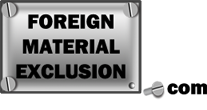 It goes without saying (or with saying since you’re reading this article), that regular inspection of equipment is a must in Foreign Material Exclusion. Worn down equipment can shed parts, debris, or chemicals which can be harder to retrieve than the original item itself.
It goes without saying (or with saying since you’re reading this article), that regular inspection of equipment is a must in Foreign Material Exclusion. Worn down equipment can shed parts, debris, or chemicals which can be harder to retrieve than the original item itself.
Items should be prioritized based on breakdown rates and potential damage caused by lost parts. Those items with a high risk of breakdown and a high level of expense, either safety or economic, associated with them should be inspected more frequently than those items that pose little threat of breaking down. For example, a solid metal wrench with no moving parts may only need inspection once a year, while a multi-function power drill with deluxe toothbrush attachments and dog leash retractor may need inspections daily.
Equipment inspection criteria include:
Item complexity
The more complicated a piece of equipment, the more that can go wrong with it. Complicated tools with many moving parts should be examined frequently. Simple tools need less frequent inspection.
Item cost
The more an item costs the more important it is that the item stays in good condition. Expensive items should be well maintained to prevent unnecessary replacement. Cheaper items may be treated as consumable and may not need frequent inspection.
Item composition (frailty)
Equipment that is made of durable materials such as metals should need less frequent examination than materials that deteriorate more quickly with use such as fabrics and plastics.
Known breakdown rate
Anything that has a history of frequent failure should be inspected more often. If a particular brand of tool is known to start experiencing issues after use on a certain job, then that tool should have inspections scheduled accordingly.
Failure costs (both safety and economic)
If the consequence of a failing product will result in a significant loss of money or a potential employee injury then the item should be inspected more frequently. For example, parachutes and fall protection equipment would be inspected before every use.
Retrievability
Items that are considered easily retrievable will need less frequent inspection than those items that could not be retrieved should a failure occur.


 Use our lanyard selection form and we'll help you get the right lanyards for the job.
Use our lanyard selection form and we'll help you get the right lanyards for the job.